Sociology: Artificial Intelligence in Construction Industry Impact
VerifiedAdded on 2022/09/09
|5
|1138
|12
Report
AI Summary
This report investigates the digital transformation of the construction industry through the implementation of artificial intelligence (AI). It explores how AI aims to increase efficiency, productivity, and sustainability. The research emphasizes the importance of human-AI trust for the successful integration of AI tools. The literature review highlights the industry's shift towards digitization, the benefits of AI such as reduced errors and improved user experience, and the challenges related to safety, scheduling, and cost. It also discusses the significance of AI-human interaction and the need for human oversight to enhance AI system effectiveness. The report references several studies that analyze AI's impact on construction processes, accident reduction, and the modification of construction methods. The study concludes by emphasizing how AI is revolutionizing construction practices and improving working rates.
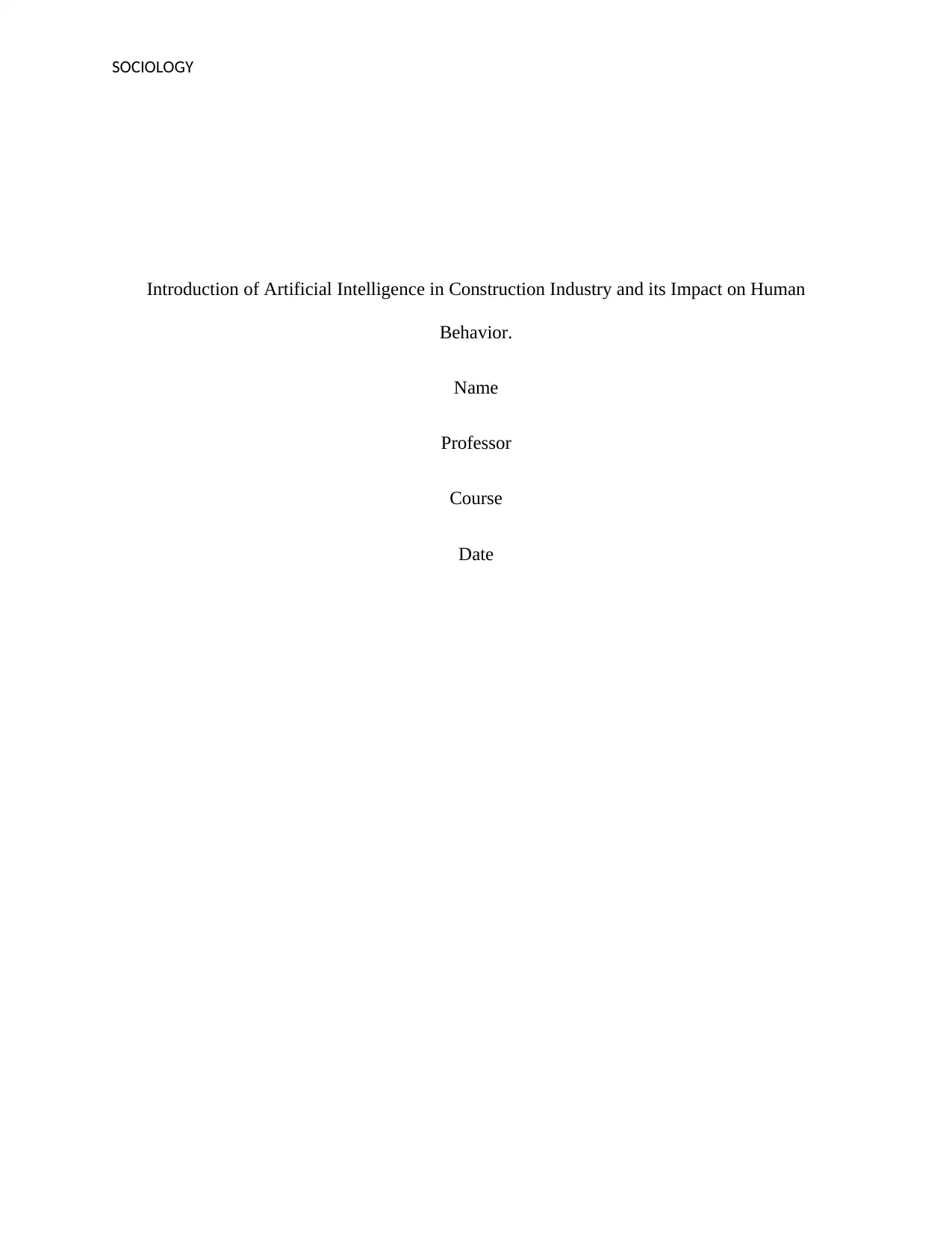
SOCIOLOGY
Introduction of Artificial Intelligence in Construction Industry and its Impact on Human
Behavior.
Name
Professor
Course
Date
Introduction of Artificial Intelligence in Construction Industry and its Impact on Human
Behavior.
Name
Professor
Course
Date
Paraphrase This Document
Need a fresh take? Get an instant paraphrase of this document with our AI Paraphraser
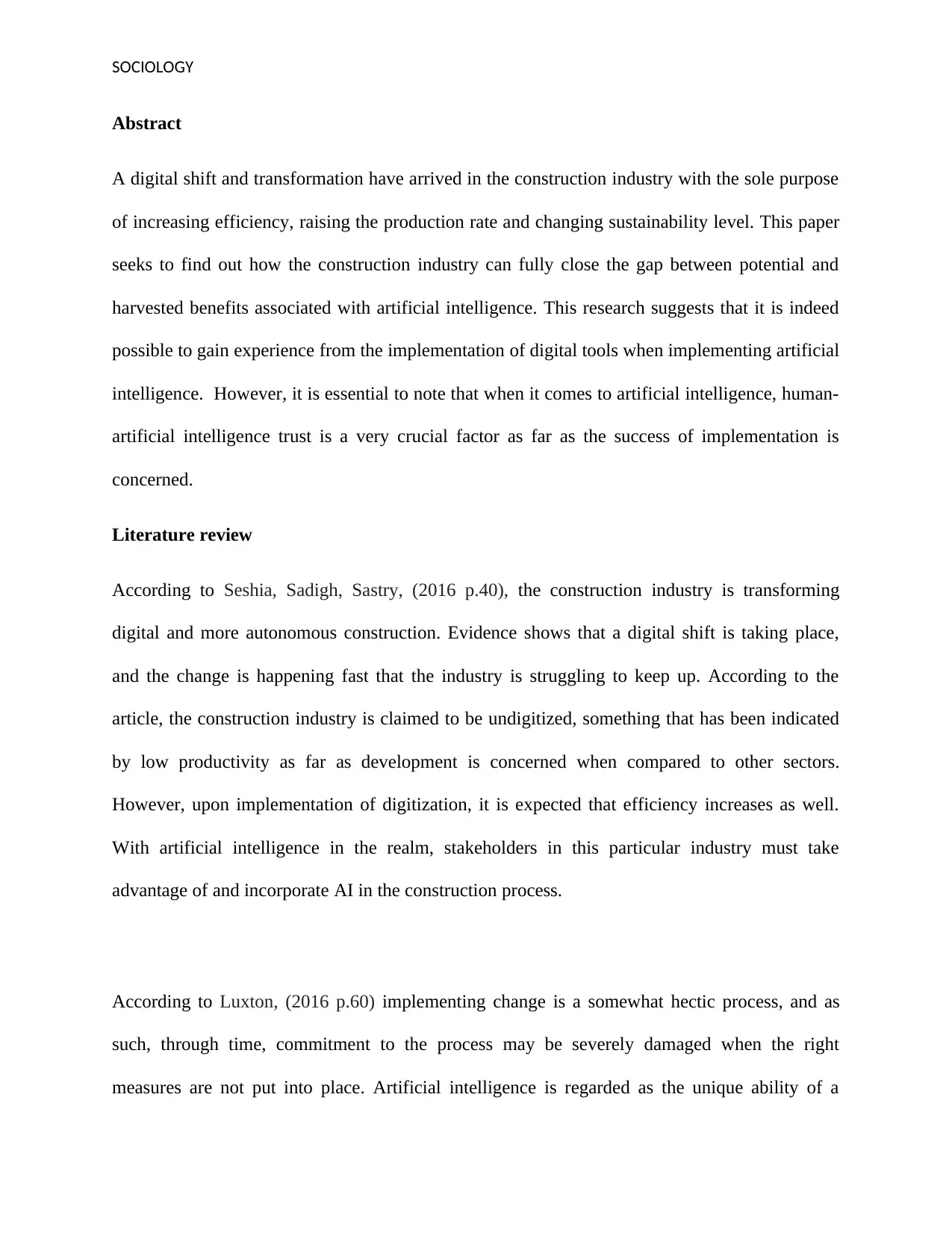
SOCIOLOGY
Abstract
A digital shift and transformation have arrived in the construction industry with the sole purpose
of increasing efficiency, raising the production rate and changing sustainability level. This paper
seeks to find out how the construction industry can fully close the gap between potential and
harvested benefits associated with artificial intelligence. This research suggests that it is indeed
possible to gain experience from the implementation of digital tools when implementing artificial
intelligence. However, it is essential to note that when it comes to artificial intelligence, human-
artificial intelligence trust is a very crucial factor as far as the success of implementation is
concerned.
Literature review
According to Seshia, Sadigh, Sastry, (2016 p.40), the construction industry is transforming
digital and more autonomous construction. Evidence shows that a digital shift is taking place,
and the change is happening fast that the industry is struggling to keep up. According to the
article, the construction industry is claimed to be undigitized, something that has been indicated
by low productivity as far as development is concerned when compared to other sectors.
However, upon implementation of digitization, it is expected that efficiency increases as well.
With artificial intelligence in the realm, stakeholders in this particular industry must take
advantage of and incorporate AI in the construction process.
According to Luxton, (2016 p.60) implementing change is a somewhat hectic process, and as
such, through time, commitment to the process may be severely damaged when the right
measures are not put into place. Artificial intelligence is regarded as the unique ability of a
Abstract
A digital shift and transformation have arrived in the construction industry with the sole purpose
of increasing efficiency, raising the production rate and changing sustainability level. This paper
seeks to find out how the construction industry can fully close the gap between potential and
harvested benefits associated with artificial intelligence. This research suggests that it is indeed
possible to gain experience from the implementation of digital tools when implementing artificial
intelligence. However, it is essential to note that when it comes to artificial intelligence, human-
artificial intelligence trust is a very crucial factor as far as the success of implementation is
concerned.
Literature review
According to Seshia, Sadigh, Sastry, (2016 p.40), the construction industry is transforming
digital and more autonomous construction. Evidence shows that a digital shift is taking place,
and the change is happening fast that the industry is struggling to keep up. According to the
article, the construction industry is claimed to be undigitized, something that has been indicated
by low productivity as far as development is concerned when compared to other sectors.
However, upon implementation of digitization, it is expected that efficiency increases as well.
With artificial intelligence in the realm, stakeholders in this particular industry must take
advantage of and incorporate AI in the construction process.
According to Luxton, (2016 p.60) implementing change is a somewhat hectic process, and as
such, through time, commitment to the process may be severely damaged when the right
measures are not put into place. Artificial intelligence is regarded as the unique ability of a
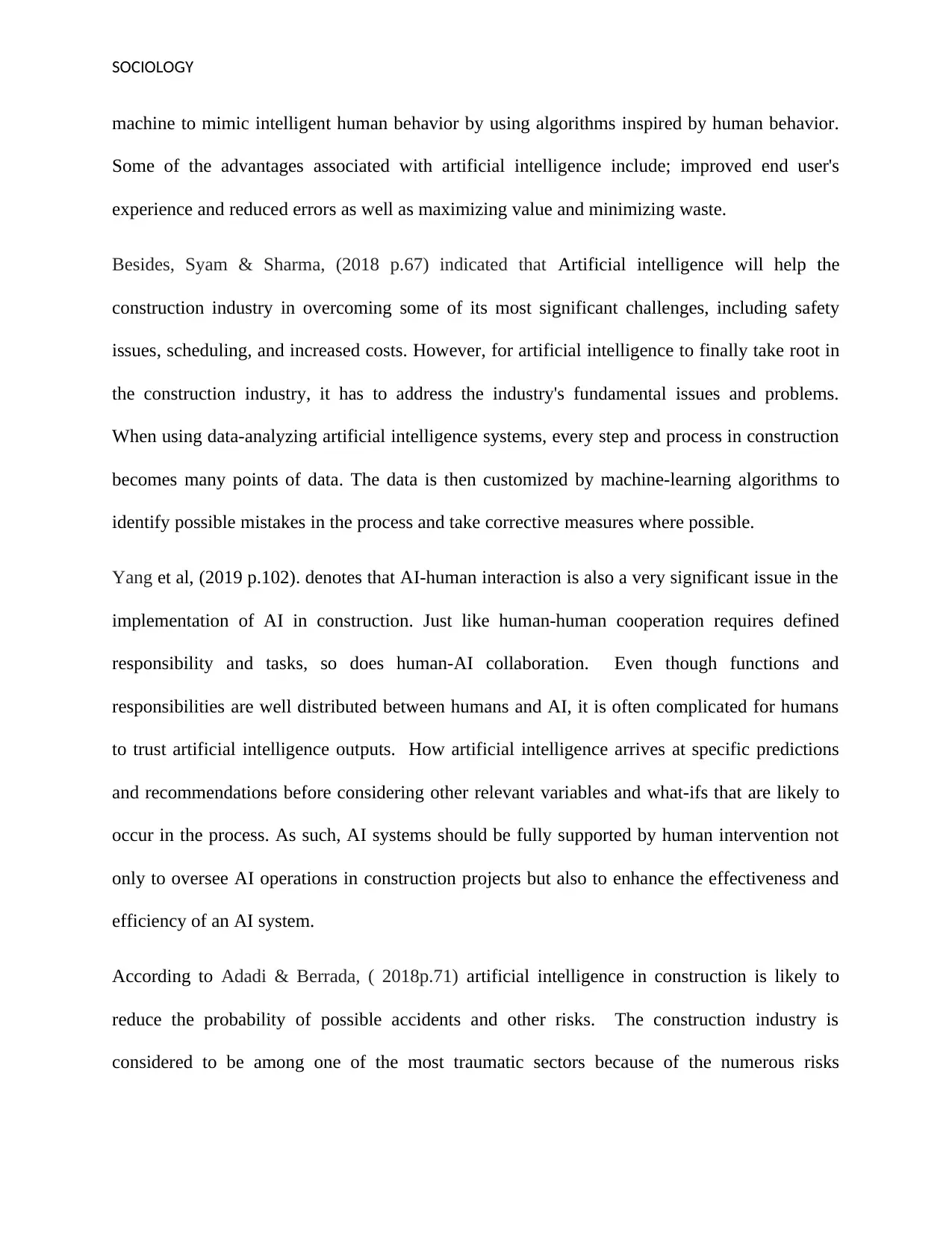
SOCIOLOGY
machine to mimic intelligent human behavior by using algorithms inspired by human behavior.
Some of the advantages associated with artificial intelligence include; improved end user's
experience and reduced errors as well as maximizing value and minimizing waste.
Besides, Syam & Sharma, (2018 p.67) indicated that Artificial intelligence will help the
construction industry in overcoming some of its most significant challenges, including safety
issues, scheduling, and increased costs. However, for artificial intelligence to finally take root in
the construction industry, it has to address the industry's fundamental issues and problems.
When using data-analyzing artificial intelligence systems, every step and process in construction
becomes many points of data. The data is then customized by machine-learning algorithms to
identify possible mistakes in the process and take corrective measures where possible.
Yang et al, (2019 p.102). denotes that AI-human interaction is also a very significant issue in the
implementation of AI in construction. Just like human-human cooperation requires defined
responsibility and tasks, so does human-AI collaboration. Even though functions and
responsibilities are well distributed between humans and AI, it is often complicated for humans
to trust artificial intelligence outputs. How artificial intelligence arrives at specific predictions
and recommendations before considering other relevant variables and what-ifs that are likely to
occur in the process. As such, AI systems should be fully supported by human intervention not
only to oversee AI operations in construction projects but also to enhance the effectiveness and
efficiency of an AI system.
According to Adadi & Berrada, ( 2018p.71) artificial intelligence in construction is likely to
reduce the probability of possible accidents and other risks. The construction industry is
considered to be among one of the most traumatic sectors because of the numerous risks
machine to mimic intelligent human behavior by using algorithms inspired by human behavior.
Some of the advantages associated with artificial intelligence include; improved end user's
experience and reduced errors as well as maximizing value and minimizing waste.
Besides, Syam & Sharma, (2018 p.67) indicated that Artificial intelligence will help the
construction industry in overcoming some of its most significant challenges, including safety
issues, scheduling, and increased costs. However, for artificial intelligence to finally take root in
the construction industry, it has to address the industry's fundamental issues and problems.
When using data-analyzing artificial intelligence systems, every step and process in construction
becomes many points of data. The data is then customized by machine-learning algorithms to
identify possible mistakes in the process and take corrective measures where possible.
Yang et al, (2019 p.102). denotes that AI-human interaction is also a very significant issue in the
implementation of AI in construction. Just like human-human cooperation requires defined
responsibility and tasks, so does human-AI collaboration. Even though functions and
responsibilities are well distributed between humans and AI, it is often complicated for humans
to trust artificial intelligence outputs. How artificial intelligence arrives at specific predictions
and recommendations before considering other relevant variables and what-ifs that are likely to
occur in the process. As such, AI systems should be fully supported by human intervention not
only to oversee AI operations in construction projects but also to enhance the effectiveness and
efficiency of an AI system.
According to Adadi & Berrada, ( 2018p.71) artificial intelligence in construction is likely to
reduce the probability of possible accidents and other risks. The construction industry is
considered to be among one of the most traumatic sectors because of the numerous risks
⊘ This is a preview!⊘
Do you want full access?
Subscribe today to unlock all pages.

Trusted by 1+ million students worldwide
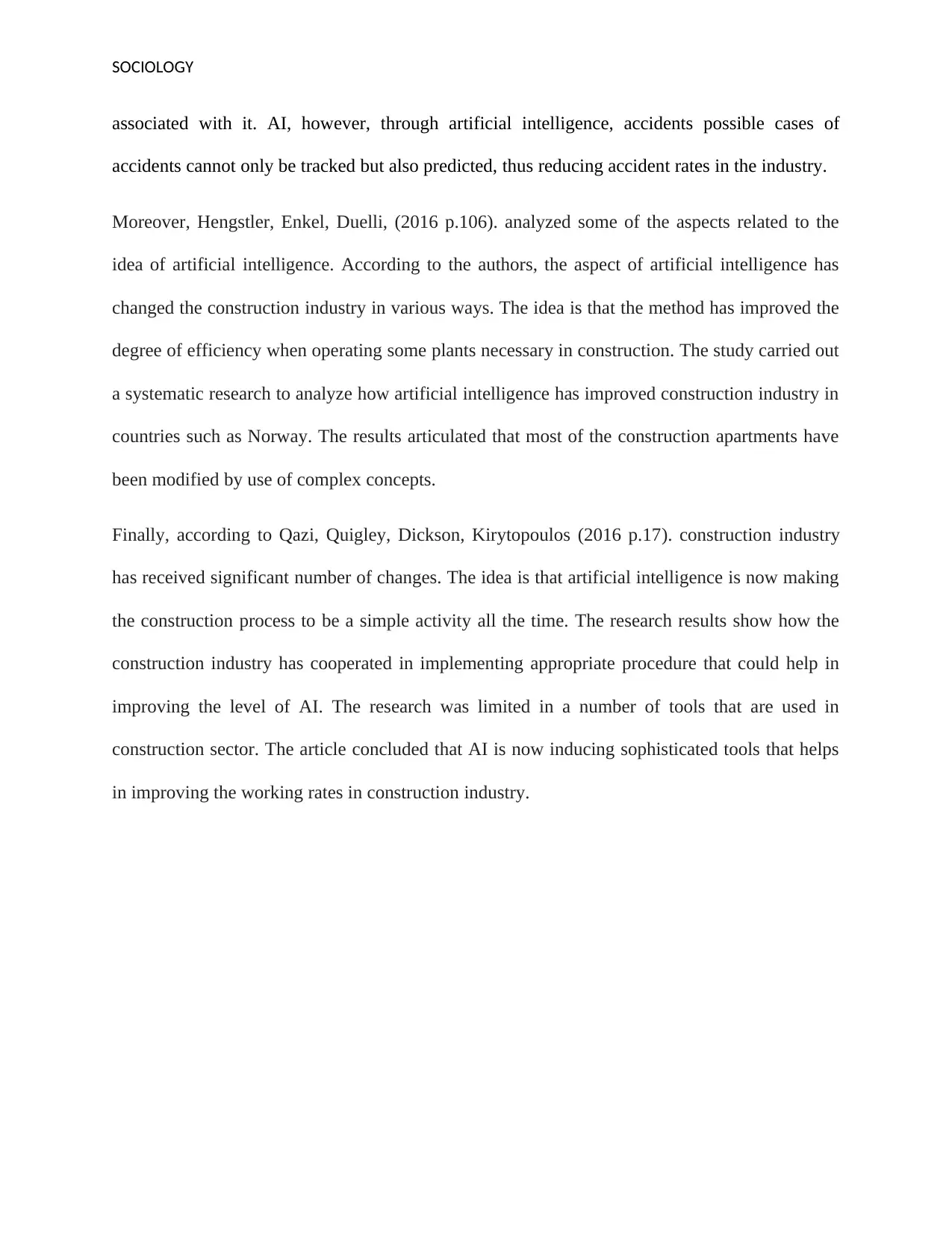
SOCIOLOGY
associated with it. AI, however, through artificial intelligence, accidents possible cases of
accidents cannot only be tracked but also predicted, thus reducing accident rates in the industry.
Moreover, Hengstler, Enkel, Duelli, (2016 p.106). analyzed some of the aspects related to the
idea of artificial intelligence. According to the authors, the aspect of artificial intelligence has
changed the construction industry in various ways. The idea is that the method has improved the
degree of efficiency when operating some plants necessary in construction. The study carried out
a systematic research to analyze how artificial intelligence has improved construction industry in
countries such as Norway. The results articulated that most of the construction apartments have
been modified by use of complex concepts.
Finally, according to Qazi, Quigley, Dickson, Kirytopoulos (2016 p.17). construction industry
has received significant number of changes. The idea is that artificial intelligence is now making
the construction process to be a simple activity all the time. The research results show how the
construction industry has cooperated in implementing appropriate procedure that could help in
improving the level of AI. The research was limited in a number of tools that are used in
construction sector. The article concluded that AI is now inducing sophisticated tools that helps
in improving the working rates in construction industry.
associated with it. AI, however, through artificial intelligence, accidents possible cases of
accidents cannot only be tracked but also predicted, thus reducing accident rates in the industry.
Moreover, Hengstler, Enkel, Duelli, (2016 p.106). analyzed some of the aspects related to the
idea of artificial intelligence. According to the authors, the aspect of artificial intelligence has
changed the construction industry in various ways. The idea is that the method has improved the
degree of efficiency when operating some plants necessary in construction. The study carried out
a systematic research to analyze how artificial intelligence has improved construction industry in
countries such as Norway. The results articulated that most of the construction apartments have
been modified by use of complex concepts.
Finally, according to Qazi, Quigley, Dickson, Kirytopoulos (2016 p.17). construction industry
has received significant number of changes. The idea is that artificial intelligence is now making
the construction process to be a simple activity all the time. The research results show how the
construction industry has cooperated in implementing appropriate procedure that could help in
improving the level of AI. The research was limited in a number of tools that are used in
construction sector. The article concluded that AI is now inducing sophisticated tools that helps
in improving the working rates in construction industry.
Paraphrase This Document
Need a fresh take? Get an instant paraphrase of this document with our AI Paraphraser
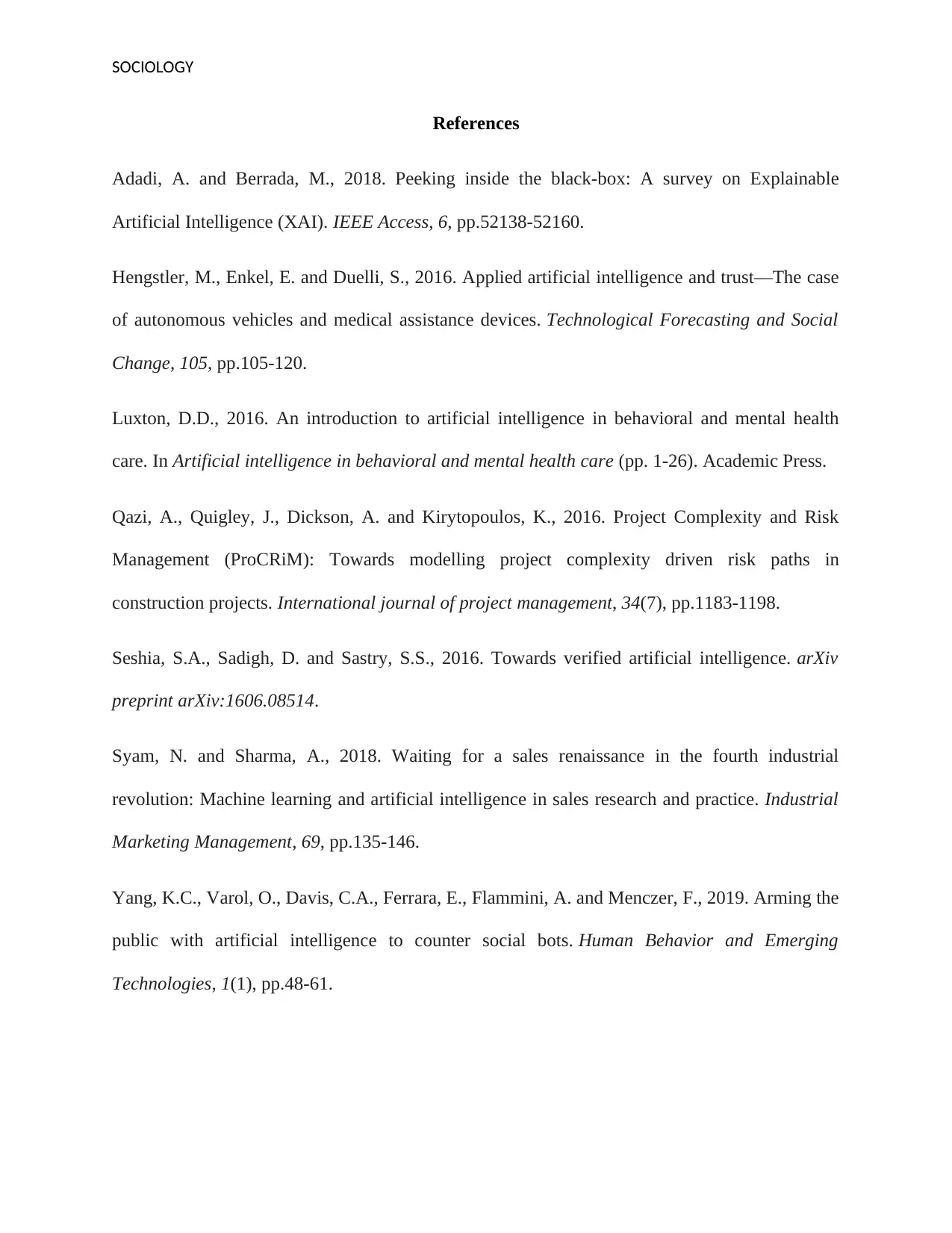
SOCIOLOGY
References
Adadi, A. and Berrada, M., 2018. Peeking inside the black-box: A survey on Explainable
Artificial Intelligence (XAI). IEEE Access, 6, pp.52138-52160.
Hengstler, M., Enkel, E. and Duelli, S., 2016. Applied artificial intelligence and trust—The case
of autonomous vehicles and medical assistance devices. Technological Forecasting and Social
Change, 105, pp.105-120.
Luxton, D.D., 2016. An introduction to artificial intelligence in behavioral and mental health
care. In Artificial intelligence in behavioral and mental health care (pp. 1-26). Academic Press.
Qazi, A., Quigley, J., Dickson, A. and Kirytopoulos, K., 2016. Project Complexity and Risk
Management (ProCRiM): Towards modelling project complexity driven risk paths in
construction projects. International journal of project management, 34(7), pp.1183-1198.
Seshia, S.A., Sadigh, D. and Sastry, S.S., 2016. Towards verified artificial intelligence. arXiv
preprint arXiv:1606.08514.
Syam, N. and Sharma, A., 2018. Waiting for a sales renaissance in the fourth industrial
revolution: Machine learning and artificial intelligence in sales research and practice. Industrial
Marketing Management, 69, pp.135-146.
Yang, K.C., Varol, O., Davis, C.A., Ferrara, E., Flammini, A. and Menczer, F., 2019. Arming the
public with artificial intelligence to counter social bots. Human Behavior and Emerging
Technologies, 1(1), pp.48-61.
References
Adadi, A. and Berrada, M., 2018. Peeking inside the black-box: A survey on Explainable
Artificial Intelligence (XAI). IEEE Access, 6, pp.52138-52160.
Hengstler, M., Enkel, E. and Duelli, S., 2016. Applied artificial intelligence and trust—The case
of autonomous vehicles and medical assistance devices. Technological Forecasting and Social
Change, 105, pp.105-120.
Luxton, D.D., 2016. An introduction to artificial intelligence in behavioral and mental health
care. In Artificial intelligence in behavioral and mental health care (pp. 1-26). Academic Press.
Qazi, A., Quigley, J., Dickson, A. and Kirytopoulos, K., 2016. Project Complexity and Risk
Management (ProCRiM): Towards modelling project complexity driven risk paths in
construction projects. International journal of project management, 34(7), pp.1183-1198.
Seshia, S.A., Sadigh, D. and Sastry, S.S., 2016. Towards verified artificial intelligence. arXiv
preprint arXiv:1606.08514.
Syam, N. and Sharma, A., 2018. Waiting for a sales renaissance in the fourth industrial
revolution: Machine learning and artificial intelligence in sales research and practice. Industrial
Marketing Management, 69, pp.135-146.
Yang, K.C., Varol, O., Davis, C.A., Ferrara, E., Flammini, A. and Menczer, F., 2019. Arming the
public with artificial intelligence to counter social bots. Human Behavior and Emerging
Technologies, 1(1), pp.48-61.
1 out of 5
Related Documents
Your All-in-One AI-Powered Toolkit for Academic Success.
+13062052269
info@desklib.com
Available 24*7 on WhatsApp / Email
![[object Object]](/_next/static/media/star-bottom.7253800d.svg)
Unlock your academic potential
Copyright © 2020–2025 A2Z Services. All Rights Reserved. Developed and managed by ZUCOL.




